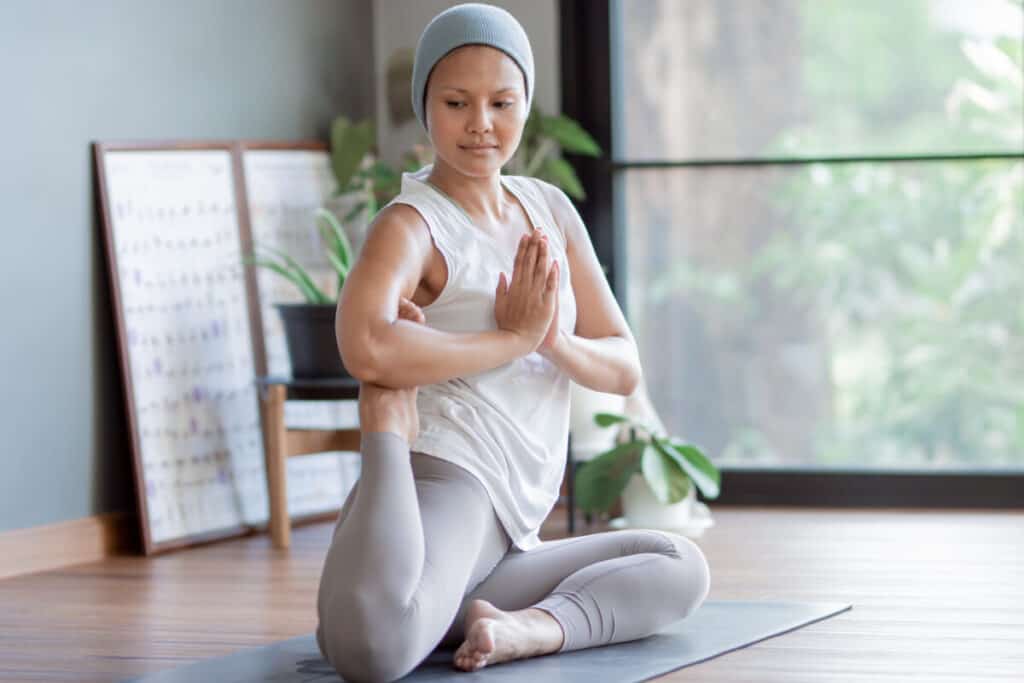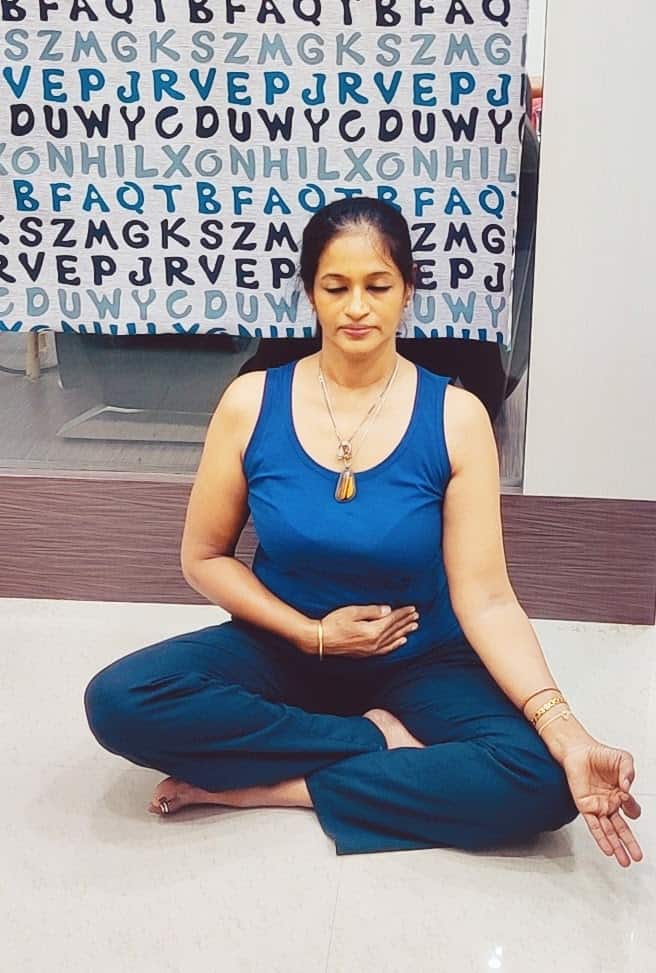Sandra endured a tortuous period of chemotherapy and treatment for her breast cancer. Unfortunately, Sandra always felt exhausted. She need more energy to recuperate and get her life back to normal. Being a cancer survivor is no easy feat. It means you have stared at death and the Gods have decided to give you another chance at life. So, what do the millions who sail in the same boat as Sandra get their depleted energy levels back? How can they continue with life on an even tempo? Let’s look at how yoga and the ancient Indian system of breathing techniques, called Pranayama, can help cancer survivors.

Those who start practicing the pranayama everyday, religiously as a habit, become empowered to battle any ailment. Starting from the respiratory disorders to many other problems, they develop physical, mental, and spiritual immunity towards everything. This is the strength that the regular practice of all forms of pranayama or the breathing techniques give us. Sadly, many people, still have remissions even after being cancer-free for months or years. That is the most dangerous as well as the excruciatingly painful part.
The Pranayama practice can be helpful to manage and control the growth of cancer cells…
This is what the Pranayama practice is good for- to manage and control the growth of cancer cells. Pranayama also has the propensity to control the remission of such a deadly disease. The following yoga and Pranayama methods will reduce the negative effects of cancer for survivors. By strengthening the immune system, reducing stress, and detoxifying the body, these yoga and pranayama techniques may also help prevent cancer, too!
The Best Yoga and Pranayama Techniques to Help Cancer Survivors:
- Breath Awareness
- Ujjayi Pranayama Breathing Technique
- Nadi Shodhana Pranayama or Alternate Nostril Breathing
- Kapalabhati Pranayama
- Vipareetha Karani Mudra
The breathing protocol that we follow has the four important inhalation and exhalation processes. They possess the power to bring order from chaos; to remove the toxins that are always there in our systems. By adopting these Pranayama techniques, we can and should aspire to start living a life free of cancer. For, thinking positive is the very first step.
1. Breath Awareness
This helps us in becoming aware of our breathing processes. First, sit in a normal squatting pose or the Sukhasana or the Swastikasana. Then the next step is to keep the hands in chin mudra and the Nasika mudra respectively. The left hand in the chin mudra mode, and the right hand in the Nasika mudra mode. Then, we need to slowly withdraw unto ourselves, and then focus completely on our breathing- the inhalation and the exhalation. This is a very important part of the Pranayama process- the ability to focus on our inhalation and the exhalation, with great intent.
This focus on the inhalation and the exhalation is the first step that sets off the entire breathing process for preventing cancer into motion. First, calm your mind for about 6 or 7 minutes. Become grounded. Become fixed in the breathing procedure. Be conscious of each breath. So, the first step or the initial part of the process is to be totally aware of our inhalation and the subsequent exhalation.
2. Ujjayi Pranayama Breathing Technique

This process of breathing called the Ujjayi Breathing is a technique that helps remove the toxins to get out of the system and regulate the inhalation and the exhalation. First, we must understand that the breathing in this technique happens via the nostril. So, as usual, the first step is to sit in normal Swastikasana and then placing the hands on our thighs. First, close your mouth and then constrict your throat. Create the sound of a swishing ocean or wind when you inhale and exhale. Press your “glottis” b your throat muscles. Consequently, this ocean or wind and the sound comes as inhalation and exhalation happens.
We create this “swishing” sound because of a friction of air inside the throat. The actual sound is that of the ocean waters swishing with the waves. Hence, the term Ujjayi breathing or pranayama is used to describe this sound. The Ujjayi breathing is a very effective pranayama procedure, and it helps in slowly expelling the toxins from the system. The focus continues to be on the breathing process that is inhaled through the nose, and exhaled through the nose as well, but with the air or the carbon dioxide passing through a constricted glottis.
3. Nadi Shodhana Pranayama or Alternate Nostril Breathing
In the Nadi Shodhana or Alternate Nostril Breathing technique, the breathing is one of the best and the most time-tested methods to bring in mental stability, sustained physical energizing breathing and and the core strength needed to build immunity, through the lungs. This type of alternate breathing method is called Anulom Vilom also. The stance to adopt is to be seated in normal Sukhasana or the sitting position. The hands are to be in a mudra- the left hand in the Chin or the Gyan mudra and the right hand in the Naasika Mudra, respectively.
Then the alternate mode of breathing or pranayama should start, with initially inhaling with the right nostril and then exhaling through the left; followed by inhaling with the left next, and exhaling with the right. This method gives the way to be focused always and then the skill of being in a state of ever-alert, or alacrity. We are cognizant of what comes first and what follows later, at the same time, multitasking with the breath control aspect, and being in the meditative state. This technique addresses both the mental and the physical states. This is a very safe and dependable technique to help out cancer survivors, or the ones who are under the spell of cancer, or for that matter, any dis-ease.
4. Kapalabhati Pranayama

Kapalabhati is a breathing technique or a type of pranayama, that is also called Skull clearing technique or breathing. This is a compulsory step or breathing or pranayama to be included in every practice of yoga, as it has been proved that when we practice this regularly and at correct times of the day , everyday, consistently, it has a slew of benefits to offer- such as the removal of any kind of toxins from the system, the clearing of the respiratory tract, the effect of this practice will be visible, when we have a bright countenance and can actually feel the freeness and lightness when the denseness is removed. This is again a very important breathing technique or process for removing the negative aura, forces, elements and the charges around our subtle body, and start falling in line with the positively charged new ‘us’.
For Many, The Kapalabhati is a Very Positive Step in the Cancer Recovery Process
Many surveys with different subjects based on the age factor, the ethnic groups and the stage of the disease of the person, and in all instances and experiments or surveys, it was discovered that doing the Kapalabhati was a very positive step in the curing process. It was also discovered that by regularly practicing it, the instances of remission were also quite low. How does one do it?
First, sit in the Sukhasana or the Swastikasana and then keep the left hand in Chin mudra, followed by the right hand left free. Slowly, place the right hand on the abdomen, upon the navel area and then do a good inhalation, and then exhale, then again inhale deeply, followed by an exhalation. Now start the forced exhalation in quick succession, which of course will elicit a sneezing kind of noise from the nose. We call this the actual Kalapabhati. We need not worry that the inhalation is not happening at all- that is a passive inhalation that happens. Our only focus is on the exhalation process. This follows the procedure of a forced abdominal exhalation.
There are also other schools of thought of yoga. For example, where we practice the Kapalabhati so that the right hand fingers -of the thumb and the index finger hold on to the nose. Then, a forced exhalation takes place, as if we are trying to blow our nose !! (well, if you looked at the act, it does resemble that!).
5. Vipareetha Karani Mudra
The Vipareetha Karani, is another Mudra, but appears like an asana…
The Vipareetha Karani, is another Mudra, but appears like an asana. The regular practice of this mudra is in a supine position with one lying on their back and with legs raised. This creates an anti-gravity kind of posture. This posture is like an antidote to many dis-eases of the body. Although the Vipareetha (meaning opposite in Sanskrit), is like the Sarvangasana, or the shoulder stand, it is not that fully.
Yoga gives us a freehand to modify the asanas as and when we can, with the help of props and as per the person’s capabilities and afflictions. So, as far as the Vipareetha Karani is concerned, let us understand that we can attempt two variations of the same, and by lying on the floor, with our torso on the floor flat, whereas the legs are placed up the wall for complete support. The use of the wall for leg support is a sensible one, as it helps those who are in the higher age range , to take charge of the situation, act with confidence and have the enthusiasm to do the yogasanas. The following is an image of how the Vipareetha Karani is practiced , with wall support.
These specific pranayama methods help a person who is suffering from the torturous effects of chemotherapy treatment as well as cancer survivors.
For Cancer Survivors, Yoga and Pranayama Techniques Are a Powerful Complement to Traditional Cancer Treatments
The yogasanas and the pranayama techniques we describe in this post are powerful for cancer survivors. However, there is also the fact that we cannot totally leave it to the asanas as a curative aspect. The asanas are best practiced as a complement to traditional medications and medical procedures. However, Yogasana and the pranayama will definitely have a positive effect on our immune system. We don’t want that the affected person go through more painful moments because they have stopped the medications.
“We should attempt everything we can, but never be attached to the outcome.”
Traditional hindu teachings
Many times, the person who is the patient, may not have the conviction of the fact that the yogasana practice and the regular breathing practice will actually help them. This is quite understandable. Especially given the feelings of prolonged and intense pain by so many cancer patients and survivors. That is why every great teacher of yogic practice leaves it to the power and the influence and of course, the grace of the almighty for the healing part. We know that it is our duty to ensure that the correct breathing techniques and the asanas and the mudras are in operation, but we can never take the credit for the success or the failure of the curative process.
Yoga and Pranayama are not Magical Cures for Cancer Survivors. But, Have Helped Many and Have Little (If Any) Side Effects!
Everything that happens is by the Grace and by the influence of the universal power. This helps the body, mind, and spirit heal, however difficult or herculean the situation. The ultimate catalyst is the faith and the trust and the conviction that we will heal. The positive intent nullifies the negative aspect hovering around that issue somehow. Hindu Traditional teachings explain, “we should attempt everything we can, but never be attached to the outcome.”
In the end, our outcome and fate lies in the hand of the Ultimate!
References:
*This article was originally published at L’Aquila Active and was reposted with full permissions.
You can read the original article here: “How Pranayama and Yoga Can Help Cancer Survivors”








